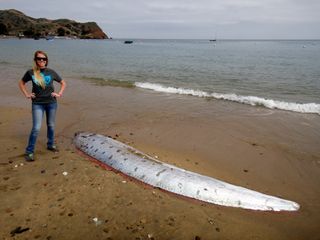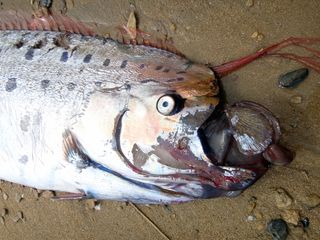Huge Beached Oarfish Sports 7-Foot-Long Ovaries

A stroll on the beach turned strange for two co-workers this week when they stumbled upon a giant (and newly deceased) deep-sea creature that had made its way ashore.
The 13.5-foot-long (4 meters) carcass that washed up on the beach of Catalina Island on Monday (June 1) was that of an oarfish, a rarely seen fish that typically sticks to deep water. The creature, which is equipped with impressively long ovaries, may have washed ashore just minutes before it was spotted, according to Amy Catalano, a conservation coordinator for the nonprofit Catalina Island Conservancy and one of the people who discovered the oarfish on the beach. [See Photos of Giant Oarfish Washed Ashore]
"It was amazing, it felt like a movie prop; it looked make-believe almost," Catalano told Reuters.
The impressively large fish was far from the first to wash up in recent years. In October 2013, an even bigger oarfish (18 feet, or 5.5 m) came ashore at Catalina Island. Just days later, a second oarfish carcass appeared on a beach just north of San Diego. And many more of these huge creatures make landfall in Baja California, Mexico, according to John Lundberg, curator of ichthyology at the Academy of Natural Sciences of Drexel University in Philadelphia.
It's not totally clear why the fish end up on land, Lundberg told Live Science, adding that there's much about these creatures that remains unknown.
"There's some suspicion that [oarfish], which live in deeper water, come closer to the surface because they're ill or because something disturbs them. And once they're out of their deep-water habitat, they tend to expire. Or it could just be old age, as far as I know," Lundberg said.
The National Oceanic and Atmospheric Administration (NOAA) lists similar reasons for why an oarfish might leave its deep-sea home, stating on its website that the fish only come to the surface when they are "injured or dying."
Sign up for the Live Science daily newsletter now
Get the world’s most fascinating discoveries delivered straight to your inbox.

When these huge and mysterious creatures do wash up on the shore from time to time, scientists take advantage of the opportunity to examine the beasts — tagging them for study in the wild has proven to be difficult, according to Lundberg.
The fish that washed up this week has already made its way to California State University, Fullerton (CSUF), where Misty Paig-Tran, an assistant professor of biology, said she'd be spending some time examining the fish's bone structure, as well as taking a closer look at the mechanics of how it feeds. Other scientists will study the oarfish's gills and muscle tissue, Paig-Tran told Live Science in an email. Paig-Tran's colleague, CSUF physiologist Kristy Forsgren, will be examining the fish's ovaries, which are 7 feet (2 m) long and weigh an astounding 24 pounds (11 kilograms).
"We are currently counting the number of developing eggs within the ovary, and would like to estimate the fish's fecundity (the reproductive potential of the fish)," Forsgren told Live Science in an email. "We will also be histologically examining the ovarian tissue to determine the reproductive status (i.e. immature, mature, reproductive) and describe ovarian developmental stages."
Rick Feeney, collections manager for the ichthyology department at the National History Museum of Los Angeles, said that Paig-Tran is not alone in wanting to know more about the oarfish's bone structure, which he described as "unusual." In her email, Paig-Tran called the animal's bones "jelly-like." Feeney also noted the fish's over-sized ovaries and unconventional digestive tract.
However, what interests Feeney most about oarfish isn't what they look like on the inside, but rather how they behave in their natural habitat. That's a subject biologists know little about, he said. But recent footage from deep-sea submersible vehicles in places like the Gulf of Mexico may provide more information about their behavior.
"We know more about how they orient themselves in the water now than we used to," Feeney told Live Science. "When they're out in the open ocean, they orient themselves vertically, with their fins spread out and in a stationary feeding position. And we didn't know that until [the] deep-sea footage came in."
But it's partly the oarfish's mysterious nature (combined with the fact that it's completely harmless to people) that makes it so appealing, according to Feeney.
"It's beautiful — almost like an alien being coming out of the deep sea," he said.
Follow Elizabeth Palermo @techEpalermo. Follow Live Science @livescience, Facebook & Google+. Original article on Live Science.

Elizabeth is a former Live Science associate editor and current director of audience development at the Chamber of Commerce. She graduated with a bachelor of arts degree from George Washington University. Elizabeth has traveled throughout the Americas, studying political systems and indigenous cultures and teaching English to students of all ages.
Most Popular




